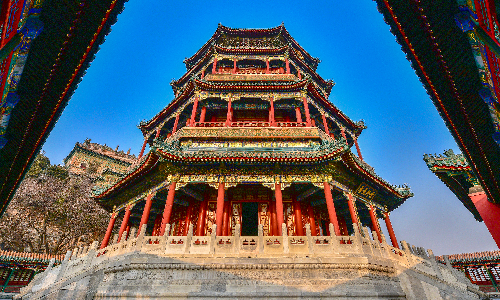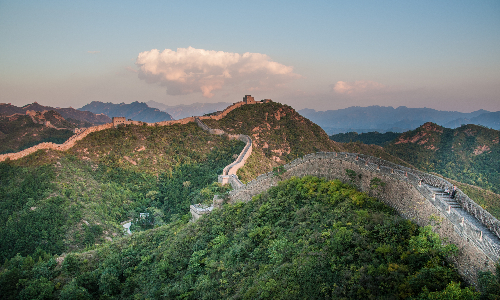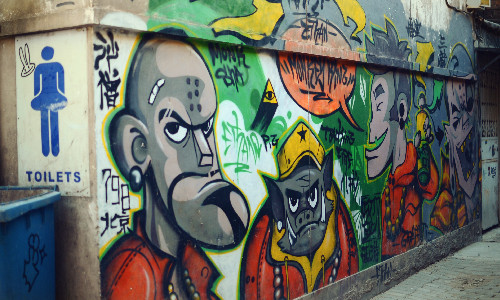If your country is on the list of 53 qualified countries for visiting China with the 144-hour visa free service, we strongly recommend you join our 5 days Beijing visa free tour. You don’t need to fill out complex forms and queue up for a long time to apply for the China Visa. Upon arrival, you just need to apply for the 144-hour visa free stay permit at the Beijing airport. Then, you can freely enjoy your China visa free tour in Beijing. Here, you can witness magnificent imperial buildings, such as the Forbidden City, the Temple of Heaven, and the Summer Palace. Here, you can appreciate the beauty of nature on the Badaling Great Wall. Here, you can have a closer look at the cute giant panda in the Beijing Zoo, and feel the contrast between the present and the past in the 798 Art District. Step out of your hustle and bustle of work, and let’s relax in this China visa free tour.

Upon your arrival at the airport, your Beijing visa free tour will begin. Walking to the arrival hall, you will see your guide holding your name sign is waiting for you. Then, you will be taken to the hotel and the guide will help you check in. You can have a rest after an exhausting long-distance flight. As one ancient capital of China during six dynasties, Beijing has a history of over 3,000 years. It preserves many relatively complete historical relics. Nowadays, as the capital of the People’s Republic of China, Beijing is the hub of politics, economy, culture, and international exchanges.
The first attraction we will visit today is Tian’anmen Square, located at the central axis of Beijing. The square covers a total area of 440,000 square meters, which can accommodate one million people. On this square, the most eye-catching building is the Tian’anmen Gate Tower. This building, first built in 1417, was the main gate tower of ancient imperial city. In front of Tian’anmen Gate Tower, there is a river called Outer Golden River with five exquisite marble bridges spanning over it. And the five bridges lead to the five arched gates of the Tian’anmen Gate Tower. The middle bridge was the widest and it was built exclusively for the emperor to pass through. So, it was called Yuluqiao (Imperial Bridge). The two bridges on each side of the Imperial Bridge were bridges for members of the royal family, which were called Wanggongqiao (Royal Bridges). And the remaining two bridges were allowed to pass through by officials ranking high and were named Pinjiqiao (Ministerial Bridges).
Then, we will walk to the Forbidden City (closed each Monday). The above-mentioned Tian’anmen Gate Tower is the main entrance to it. The Forbidden City is the largest and best-preserved palace complex in the world. It used to be the home of 24 emperors and it took 14 years to complete it from 1420-1912 by over one million workers. It is said that the Forbidden City was designed by a craftsman named Kuai Xiang. He was famous for his exquisite craftsmanship, and the finished palace is exactly the same as his blueprint. There is a widespread story about him. During the construction period of the Forbidden City, a precious piece of giant wood was paid tribute to Zhu Di, the third Emperor of the Ming Dynasty (1368-1644), by Burma. Then, Zhu Di ordered a carpenter to make it into a threshold of one main hall. However, the carpenter inadvertently sawed the wood shortened by more than a foot. He was frightened and asked Kuai Xiang for help. Kuai Xiang ordered him to saw another foot short. Then, he made innovation and transformed the wood into the first detachable threshold.
After lunch, you will head to the Temple of Heaven, the largest sacrificial site in the world with a total area of 2.73 square kilometers. It is the place for the emperors of Ming and Qing (1636-1912) dynasties to worship the God of Heaven and pray for a good harvest. The Temple of Heaven is mainly composed of Circular Mound Altar, Imperial Vault of Heaven, Hall of Prayer for Good Harvest. The Circular Mound Altar is a three-layered round altar made of bluestones and each layer was enclosed by an exquisite round white marble wall. In the middle of it, there is a round bluestone called Tianxin Stone (‘Tian’ means ‘heaven’ and ‘xin’ means heart.). In the sacrificial ceremony, the emperor would stand on the Tianxin Stone to worship the God of Heaven and pray for a good harvest. Due to the special design of the altar, visitors stand on the Tianxin Stone can hear loud echos when they say something. It is a special experience for visitors.
Then, we will drive for about 40 minutes to go to the Summer Palace, the largest and best-preserved imperial garden in the world. It was originally built in 1750 and served as a summer retreat for the Chinese royal family. The Summer Palace boasts the Kunming Lake, Longevity Hill, Seventeen-Arch Bridge, Long Corridor, Bronze Ox, and the marble boat. Besides, the Hall of Benevolence and Longevity is one exquisite building you cannot miss. In front of the hall, you can see a bronze Kylin, with a dragon’s head, a pair of antlers, a lion’s tail, and cattle’s hoofs. It is said that Kylin can live for 2,000 years, so it symbolizes longevity, peace, and happiness in China. The Kylin was made in the Qing Dynasty, and its two front legs were accidentally broken when it was moved here in 1937. Later, it was repaired, and obvious repair traces can also be seen.

After breakfast, we will drive northwest for about 1.5 hours to the Ming Tombs. Ming Tombs are the mausoleums of 13 emperors, 23 empresses, over 30 imperial concubines, 2 crown princes, and 2 eunuchs of the Ming Dynasty. The thirteen emperors’ cemeteries have similar architectural styles and arrangements. Among these tombs, the Chang Tomb is the largest, oldest, and best-preserved tomb. It was built in 1413. It is the tomb of Emperor Zhu Di, the third emperor of the Ming Dynasty. In addition, its name has two meanings. Firstly, Chang means elder in Chinese. Zhu Di is the first emperor buried here, so his tomb is the earliest tomb in Ming Tombs. Another meaning of Chang is a long sleep. Zhu Di wanted to rest in peace and watch his descendants continuing to rule the country.
In the afternoon, we will drive northwest for about 40 minutes to Badaling Great Wall, approximately 40 kilometers away from the Ming Tombs. Great Wall is an ancient military defense project in China, of which Badaling Great Wall is the best-preserved and most popular section. Because the traffic of this section is very convenient, it was called Badaling (Bada means radiating in all directions). Located on the north side of Beijing, it was a very prominent pass to protect Beijing in the past, so it was also praised as “the key to the north gate of Beijing”. Besides, Badaling Great Wall is the most popular section among foreign tourists. There are 194 independent countries in the world, and people from 178 countries have visited here, accounting for 91 percent of the total number of countries. And only visitors from 16 countries that do not have diplomatic relations with China have not been to Badaling Great Wall yet.


This morning, you will pay a visit to the hutongs. Hutongs are alleys surrounding a kind of typical Chinese traditional residences, called Siheyuan. Most existing Siheyuan in the Hutongs are relics of the Ming and Qing dynasties. In the Siheyuan, there are four houses standing on four sides around a courtyard, namely the main room (generally facing south), the opposite room, the east chamber, and the west chamber. We will arrange to take a rickshaw to explore the Hutongs and Siheyuan. Getting off the rickshaw, you can enter one Siheyuan to have a family visit. If you are interested in Chinese traditional culture, we can also arrange to learn paper cutting or Chinese calligraphy.
Then, you will go to the nearby Lama Temple, the biggest Tibetan Buddhist temple in Beijing. It was originally built in 1694 and served as the Royal Court of Prince Yong who later became Yongzheng Emperor in 1722. In 1744, the royal court was officially converted into the Lama Temple. There are three treasures in the temple, namely Sandalwood Giant Maitreya Buddha Statue, Sandalwood Buddha Niche, and Padauk-carved Five Hundred Arhats Mountain. The Sandalwood Giant Maitreya Buddha Statue, the biggest wooden Buddha statue in the world, stands in the 25-meter-high Wanfu Pavilion. The Buddha is 8 meters wide and 26 meters high in total (with 8 meters under the ground). It is carved of a 26-meter precious white sandalwood from Nepal, gifted by the seventh Dalai Lama in the 1750s.
After lunch, you will go to see cute animals in Beijing Zoo, covering an area of 860,000 square meters. First built in 1906, it is the first zoo open to public in China and now it is one of the biggest zoos in China. Besides, there are more than 500 different species in the zoo and the total number of the animals is over 5,000. There are 16 different exhibition areas and halls in Beijing Zoo. Among them, the Panda House is the most popular. The giant panda is the national treasure of China. Many visitors come here specially to see the giant pandas. Here, you may see lazy giant pandas sitting for hours and eating bamboo shoots one after another. Sometimes, you may see they are playing with each other or doing a cute roll-over, making you fall madly in love with them.


Today, you will go to the last attraction of this China visa free tour in Beijing, 798 Art District. It was built in the 1950s and named after the 798 Factory. The design style of the buildings here is Bauhaus style, featuring simply and balanced forms as well as abstract shapes. Since 2001, more and more artists and designers began to come here and set up their workshops here. Stepping into the 798 Art District, you can feel the strong contrast between the past and the present as well as the perfect combination of the industry and the art. On one side, you can see old industrial plants and crisscross pipelines. On the other side, you can see walls with bold and colorful Graffiti. Nowadays, many important international exhibitions, art activities, and fashion shows are held here. After the visit, you will be escorted to the airport according to your flight schedule. Hope you enjoy it and choose us again!


Author: Yibo Zhang
Proofreader: Yan Liu
| City | Five Star hotel list | Four Star hotel list |
|---|---|---|
| Beijing | Sunworld Dynasty Hotel Beijing Wangfujing | Sunworld Hotel Wangfujing |
 |
![]() About your child or infant, please contact us for a discounted price.
About your child or infant, please contact us for a discounted price.



We started with a few days in Beijing & ended in Shanghai, from where we visited the Forbidden City and Great Wall. In between we visited Terra Cotta Warriors Museum, Panda Base, Shanghai Disneyland.

We had a wonderful holiday in China which will remain long in the memory. China is a breathtakingly beautiful country full of splendid temples and palaces, mountains and rivers, peaceful rural scenes and bustling shopping streets.
 QUICK ENQUIRY
QUICK ENQUIRY